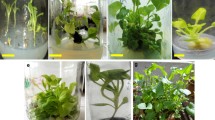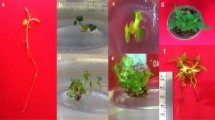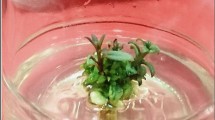Abstract
A reproducible and efficient callus-mediated shoot regeneration system was developed for the large-scale production of Valeriana jatamansi Jones., a highly medicinal plant species of global pharmaceutical importance. Effect of Murashige and Skoog (MS) medium supplemented with different concentrations of 2,4-dichlorophenoxyacetic acid (2,4-D), α-naphthaleneacetic acid (NAA) and indole-3-butyric acid (IBA) on callus induction and production of valepotriates accumulation was studied by using different explants. In V. jatamansi, the degree of callus induction varied significantly depending on explants type and the growth regulators used. Among different explants used, rhizomes have the highest callus induction potential followed by leaf. The callus induction frequency was found to be optimum in rhizome explants on media supplemented with 0.5 mg/l 2,4-D. The regenerative ability of proliferated compact calli was studied by the application of cytokinins alone and in combination with auxin. MS medium fortified with 0.75 mg/l thidiazuron in combination with 0.5 mg/l NAA showed the highest regeneration frequency (88.6 %) and produced the maximum number of shoot buds (15.20 ± 0.20) capable of growing into single plants. Vigorous callus obtained from MS medium supplemented with different concentrations of 2,4-D, NAA and IBA were used for industrially important valepotriates [acevaltrate (ACE), valtrate (VAL) and didrovaltrate (DID)] analysis. High performance liquid chromatography analysis of callus revealed that medium with 2,4-D (1 mg/l) was found responsible for increasing ACE and DID yield, whereas VAL production was higher in case of medium supplemented with NAA (1 mg/l). However, the accumulation of valepotriates in callus decreased in logarithmic phase after 8 weeks. IBA was not beneficial for the valepotriate synthesis, as it helped to accumulate significantly lower concentration of ACE, VAL and DID. Micropropagated plantlets with well-developed root system were successfully acclimatized in greenhouse condition, in root trainers containing garden soil with a survival frequency of 100 %. As Indian valerian is a highly traded medicinal plant due to extensive use of its industrially important secondary metabolites, the present system can be utilized to obtain mass multiplication of the species as well as for the stable biomass and continuous valepotriate production for the pharmaceutical industries.


Similar content being viewed by others
References
Abraham J, Cheruvathur MK, Mani B, Thomas TD (2010) A rapid in vitro multiplication system for commercial propagation of pharmaceutically important Cyclea peltata (Lam) Hook & Thoms. based on enhanced axillary branching. Ind Crops Prod 31:92–98
Akaneme FI, Ene-Obong EE (2005) Tissue culture in Pinus caribaea Mor. Var. hondurensis Barr. and Golf. I: effects of two auxins and two cytokinins on callus growth and greening. Agro Sci 4:14–23
Bello de Carvalho CM, Maurmann N, Luz DI, Fett-Neto AG, Rech SB (2004) Control of development and valepotriate production by auxins in micropropagated Valeriana glechomifolia. Plant Cell Rep 23:251–255
Bos R, Woerdenbag HJ, Hendriks H, Smit HF, Winstrom HV, Scheffer JC (1997) Composition of the essential oil from roots and rhizomes of Valeriana wallichi DC. Flav Frag J 12:123–131
Bounthanh C, Bergmann C, Beck JP, Haeg BM, Anton R (1981) Valepotriates, a new class of cytotoxic and antitumor agents. Plant Med 41:21–28
Chen S, Wang X, Wang X, Zhao B, Yuan X, Wang Y (2003) Production of crocin using Crocus sativus callus by two stage culture system. Biotechnol Lett 25:1235–1238
Christine S, Chan KL (2007) Micropropagation of Curcuma zedoaria Roscoea. and Zingiber zerumbet Smith. Biotechnology 6:555–560
De Klerk GJ, Vander KW, De Jong JC (1999) The formation of adventitious roots: new concepts, new possibilities. In Vitro Cell Dev Biol Plant 35:189–199
George EG, Sherrington PD (1984) Plant propagation by tissue culture. Handbook and directory of commercial operations. Exegetics, Basingstoke
Georgiev M, Kuzeva S, Pavlov A, Kovacheva E, Ilieva M (2006) Enhanced rosmarinic acid production by Lavandula vera MM. cell suspension culture through elicitation with vanadyl sulfate. Z Naturforsch 61:241–244
Girgune JB, Jain NK, Garg BD (1980) Antimicrobial activity of the essential oil from Valeriana wallichi DC (Valerianaceae). Ind J Microbiol 41:142–143
Gupta BK, Suri JL, Gupta GK, Atal CK (1986) Isolation and evaluation of valepotriates from Indian valerian. Indian Drugs 23:391–396
Gupta AK, Tandon N, Sharma M (2006) Valeriana jatamansi Jones. In: Gupta AK (ed) Quality standard of Indian medicinal plants, 4th edn. ICMR, New Delhi, pp 242–250
Gyves EM, Sparks CA, Fieldsend AF, Lazzeri PA, Jones HD (2001) High frequency of adventitious shoot regeneration from commercial cultivars of evening primrose (Oenothera spp.) using thidiazuron. Ann Appl Biol 138:329–332
Huetteman A, Preece EJ (1993) Thidiazuron: a potent cytokinin for woody plant tissue culture. Plant Cell Tissue Organ Cult 33:105–119
Jha P, Yadav CB, Anjaiah V, Bhat V (2009) In vitro plant regeneration through somatic embryogenesis and direct shoot organogenesis in Pennisetum glaucum (L.) R. Br. In Vitro Cell Dev Biol Plant 45:145–154
Kaur R, Sood M, Chander S, Mahajan R, Kumar V, Sharma DR (1999) In vitro propagation of Valeriana jatamansi. Plant Cell Tissue Organ Cult 59:227–229
Koroch AR, Juliani HR, Trippi VS (1997) Micropropagation and acclimatization of Hedeoma multiflorum. Plant Cell Tissue Organ Cult 48:213–217
Krishnan PN, Seeni S (1994) Rapid micropropagation of Woodfordia fruticosa (L.) Kruz (Lythraceae), rare medicinal plant. Plant Cell Rep 14:55–58
Ku KL, Chang PS, Cheng YC, Lien CY (2005) Production of stilbenoids from the callus of Arachis hypogaea a novel source of the anticancer compound piceatannol. J Agric Food Chem 53:3877–3881
Mao AA, Wetten A, Fay M, Caligari PDS (1995) In vitro propagation of Clerodendrum colebrookianum Walp., a potential natural anti-hypertension medicinal plant. Plant Cell Rep 14:493–496
Marder M, Viola H, Wasowski C, Fernandez S, Medina JH, Paladini AC (2003) 6-Methylapigenin and hesperidin: new valeriana flavonoids with activity on the CNS. Pharmacol Biochem Behav 75:537–545
Mathur A, Mathur AK, Gangwar A, Yadav S, Verma P, Sangwan RS (2010) Anthocyanin production in a callus line of Panax sikkimensis Ban. In Vitro Cell Dev Biol Plant 46:13–21
Matkowski A (2004) In vitro isoflavonoid production in callus from different organs of Pueraria lobata (Willd) Ohwi. J Plant Physiol 161:343–346
Maurmann N, Beatriz-Rech S, Fett-Neto AG (2009) Improved nutrient medium for biomass and valepotriate production in extended period stock cultures of Valeriana glechomifolia. In Vitro Cell Dev Biol Plant 44:209–215
Misra N, Misra P, Mehrotra S (2005) In vitro biosynthesis of antioxidants from Hemidesmus indicus R. BR. cultures. In Vitro Cell Dev Biol Plant 41:285–290
Mithila J, Hall JC, Victor JMR, Sexena PK (2003) Thidiazuron induces shoot organogenesis at low concentration and somatic embryogenesis at high concentration on leaf and petiole explants of African violet (Saintpaulia ionantha). Plant Cell Rep 21:408–414
Morimoto S, Goto Y, Shoyama Y (1994) Production of lithospermic acid B and rosmarinic acid in callus tissue and regenerated plantlets of Salvia miltiorhiza. J Nat Prod 57:817–823
Mungole A, Awati R, Dey S, Chaturvedi A, Zanwar P (2009) In vitro callus induction and shoot regeneration in Ipomoea obscura (L.): potent Indian medicinal plant. Indian J Sci Technol 2:24–26
Murashige T, Skoog F (1962) A revised medium for rapid growth and bioassay with tobacco tissue culture. Physiol Plant 15:473–497
Nikam TD, Savant RS (2009) Multiple shoot regeneration and alkaloid cerpegin accumulation in callus culture of Ceropegia juncea Roxb. Physiol Mol Biol Plants 15:71–77
Rout GR, Samantaray S, Das P (2000) In vitro manipulation and propagation of medicinal plants. Biotechnol Adv 18:91–120
Sanches-Gras MC, Calvo MC (1996) Micropropagation of Lavandula latifolia through nodal bud culture of mature plants. Plant Cell Tissue Organ Cult 45:259–261
Sanikhani M, Stefan F, Margrethe S (2006) TDZ induces shoot regeneration in various Kalanchoe blossfeldiana pollen cultivars in the absence of auxin. Plant Cell Tissue Organ Cult 85:75–82
Shanjani PS (2003) Nitrogen effect on callus induction and plant regeneration of Juniperus excels. Int J Agric Biol 5:419–422
Shirin F, Hossain M, Kabir MF, Roy M, Sarker SR (2007) Callus induction and plant regeneration from internodal and leaf explants of four potato (Solanum tuberosum L.) cultivars. World J Agric Sci 3:1–6
Silvia T, Apostolo N, Fernández G (2006) Calluses of Cynara cardunculus var. Cardunculus cardoon (Asteraceae): determination of cynarine and chlorogenic acid by automated high-performance capillary electrophoresis. In Vitro Cell Dev Biol Plant 42:534–537
Stintzing FC, Carle R (2004) Functional properties of anthocyanins and betalains in plants, food, and in human nutrition. Trends Food Sci Technol 15:19–38
Tefera W, Wannakrairoj S (2006) Synergistic effects of some plant growth regulators on in vitro shoot proliferation of korarima (Aframomum corrorima (Braun) Jansen). Afr J Biotechnol 5:1894–1901
Thomas TD (2003) Thiadiazuron induced multiple shoot induction and plant regeneration from cotyledonary explants of mulberry. Biol Plant 46:529–533
Thomas TD (2007) Pretreatment in thidiazuron improves the in vitro shoot induction from leaves in Curculigo orchioides Gaertn., an endangered medicinal plant. Acta Physiol Plant 29:455–461
Thomas TD (2009) Isolation, callus formation and plantlet regeneration from mesophyll protoplasts of Tylophora indica (Burm. f.) Merrill. a medicinal plant. In Vitro Cell Dev Biol Plant 45:591–598
Vanisree M, Tsay HS (2004) Plant cell cultures—an alternative and efficient source for the production of biologically important secondary metabolites. Int J Appl Sci Eng 2:29–48
Verpoorte R, Contin A, Memelink J (2002) Biotechnology for the production of plant secondary metabolites. Phytochem Rev 1:13–25
Wasowski C, Marder M, Viola H, Medina JH, Paladini AC (2002) Isolation and identification of 6-methylapigenin, a competitive ligand for the brain GABAA receptors, from Valeriana wallichi. Planta Med 68:934–936
Xu L, Najeeb U, Raziuddin R, Shen WQ, Shou JY, Tang GX, Zhou WJ (2009) Development of an efficient tissue culture protocol for callus formation and plant regeneration of wetland species Juncus effusus L. In Vitro Cell Dev Biol Plant 45:610–618
Yan M, Xu C, Chun-Hwan K, Yeong-Cheol U, Amadou AB, De-Ping G (2009) Effects of explant type culture media and growth regulators on callus induction and plant regeneration of Chinese jiaotou (Allium chinense). Sci Hortic 123:124–128
Zhang Z, Hanna W, Ozias-Akins P (2007) Comparison of callus induction and plant regeneration from different explants in triploid and tetraploid turf-type Bermuda grasses. Plant Cell Tissue Organ Cult 90:71–78
Zhao J, Davis LC, Verpoorte R (2005) Elicitor signal transduction leading to production of plant secondary metabolites. Biotechnol Adv 23:283–333
Acknowledgments
The authors are thankful to the Joint Director, BSI, Shillong, for providing the facilities and to the Department of Biotechnology (DBT), Government of India, New Delhi, India, for the award of research fellowship to J.D.
Author information
Authors and Affiliations
Corresponding author
Additional information
Communicated by J. Van Huylenbroeck.
Rights and permissions
About this article
Cite this article
Das, J., Mao, A.A. & Handique, P.J. Callus-mediated organogenesis and effect of growth regulators on production of different valepotriates in Indian valerian (Valeriana jatamansi Jones.). Acta Physiol Plant 35, 55–63 (2013). https://doi.org/10.1007/s11738-012-1047-2
Received:
Revised:
Accepted:
Published:
Issue Date:
DOI: https://doi.org/10.1007/s11738-012-1047-2




